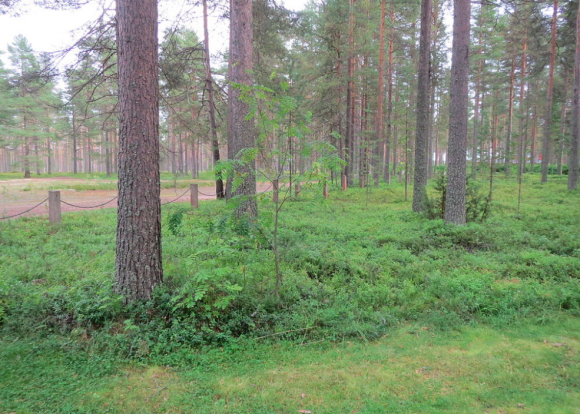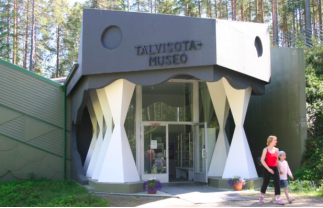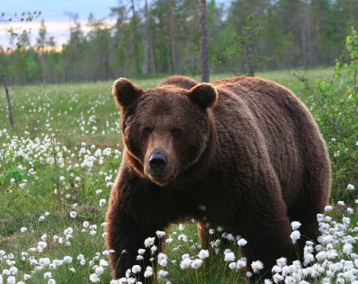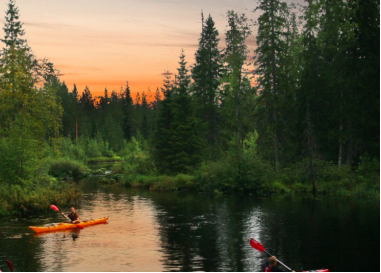Kuhmo 作者: 来源: 发布时间:2021-10-15
一、所属省或是州,具体位置,人口,面积
Kuhmo is a town and a municipality in Finland and is located at the south-eastern corner of the Kainuu region. The municipality has a population of 8,140 (31 July 2020) and covers an area of 5,456.78 square kilometres (2,106.87 sq mi) of which 649.97 km2 (250.95 sq mi) is water. The population density is 1.69 inhabitants per square kilometre (4.4/sq mi). It has a borderline of 120 kilometres (75 mi) with Russia (Finnish-Russian border). Neighbour towns are Hyrynsalmi, Lieksa, Nurmes, Ristijärvi, Sotkamo and Suomussalmi. A neighbour city across the Russian border is Kostomuksha. Vartius, one of the border crossing points between Finland and Russia, is located in northern Kuhmo. Kuhmo´s eastern border is located at a drainage divider and town area belongs to drainage basin of Oulujärvi.

二、自然地理
1.地理条件
By area the municipality is the second largest in the region (and the twelfth largest in the country), covering twice the land area of Luxembourg. The population is heavily concentrated in Kuhmo-town. Most of the area is very wild, featuring more than 600 lakes and for the rest extensively forested, providing a home to abundant wild life that includes bears, wolves and Finnish forest reindeer.
The Ministry of Agriculture and Forestry has set Kuhmo as a part of Eastern Finland´s stable bear population area. According to the plan, the population density of bears in this area will be maintained higher than in the rest of the country. The wolf population is also dense by comparison to the rest of the country. In consequence, the number of reindeer has decreased lately.
The topography is made up of low hills, of which the most significant are near the Russian frontier on the eastern side. To the south, Kuhmo is bordered by North Karelia. Several nature reserves have been founded in Kuhmo for the protection of the frontier wilderness. Forest administration maintains several hiking routes on the reserves and almost all are accessible to the public.
2.交通情况
Regional road 912 runs from Kuhmo to Suomussalmi. The city aims to turn this region into a main road. Highway 89 starts from Highway 22 in Piesamo's Mieslahti and runs north of Kontiomäki to the Vartius border station in Kuhmo, from where it continues to Russia. Main road 75 comes to Kuhmo from Siilinjärvi via Nurmes. Main road 76 leads from Sotkamo from the junction of highway 6 to the center of Kuhmo. Regional road 524 runs from Lieksa to Kuhmo. There is a daily bus connection from Kuhmo to Kajaani and a twice-weekly service to Suomussalmi during school hours.
三、经济发展和规模
According to the current urban strategy of the city of Kuhmo, Kuhmo is globally known as a success story of the bioeconomy in the middle of the forest. The balance of the city's economy is one of the priorities for action. A sound economy enables the organization of quality services based on the urban strategy, the development of vitality and, in the long run, the independent operation of the city.
Key figures in the financial statements:
TP 2017 TP 2016
Population, number 8 499 8 644
Tax rate,% 21.5 21.5
Operating income, t € 7,003 6,890
Operating expenses, t € -66 663 -66 733
Operating margin, t € -59,660 -59,843
Tax revenue, t € 29,097 28,706
Government contributions, t € 32,233 32,534
Financial income and expenses, t € 1,193,908
Annual margin, t € 2,864 2,306
Extraordinary income / expenses, t € 0 267
Profit for the financial year, t € 594,564
Loan portfolio, t € 36,524 26,240
Loans / resident, € 4,297 3,036
Net debt, t € 14,387 6,898
Net debt / resident, € 1,692,798
Net investments, t € 13,555 6,231
Accumulated surplus, t € 2,921 2,327
The strategy of the city of Kuhmo is drawn up for each council term. The need for updating is reviewed annually before budget processes begin. The budget includes a strategy-based action plan and indicators for the budget year. The implementation of the action plan will be monitored in connection with the quarterly reporting. The Kuhmo city strategy has been approved at the city council meeting on 17 October 2017.
The budget book sets out the financial and operational objectives for the coming budget year and the next two years of the action plan for the mayor and the city's group companies.
In addition to the financial objectives (income statement, financial statement), the main content of the budget book is a description of the city's target image and strategic objectives, as well as the action plan for the budget year based on the strategy. The action plan describes the measures to be taken to implement the urban strategy during the budget year and the indicators set to achieve the objectives. The budget book also includes a risk assessment of the city and the Group companies for both strategic and operational risks, as well as an action plan to minimize the materialisation of risks.
Key economic indicators for the financial year 2020 (urban mother):
Budget 2020 Forecast 2019 Difference
Operating income, t € 6,207 6,083,124
Operating expenses, t € - 67,007 - 66,777,230
Operating margin, t € - 60,799 - 60,694 -105
Tax revenue, t € 29,404 28,243 1,161
Government contributions, t € 32,874 32,110,764
Financial income and expenses, t € 1,721 1,223,498
Annual margin, t € 3,200,882 2,318
Depreciation - 2,593 - 2,600 - 7
Impairment losses - 319 - 795 - 476
Reduction of depreciation difference 42 42 0
Surplus / deficit for the financial year - 146 - 1 995 - 1 849
The city's financial statements include the balance sheet, income statement, cash flow statement and their notes, as well as the budget outturn comparison and the report of the Board of Directors. The financial statements also include the city group's consolidated financial statements. The interim reports examine the development of finances and operations as well as the degree of implementation of the action plan. The financial year of the city of Kuhmo is the calendar year. The City Board will review the financial statements at the turn of March-April at the latest and the City Council by the end of May. The Audit Board prepares an audit report before the Board's deliberations. The audit firm of the City of Kuhmo and its subsidiaries is KPMG Oy Ab, with Antti Kääriäinen, Authorized Public Accountant, as the principal auditor. Interim reports are prepared quarterly (April 30 and August 30). The interim reports are part of the operational and financial control and monitoring system.
The vitality of the area and the well-being of the people in the area must also be able to be distinguished from the economic situation of the municipalities. There can be vibrant areas, companies and people all over Finland, from south to north. Digitalisation has opened up the market for exports in a whole new way. For example, the market for a small stone foot trade in Kuhmo today can be the whole world. Many say that several smaller municipalities and cities have failed and are downhill. If we always thought so gloomily, quite a few tourist centers would not have been opened, a mine would not have been created and a wood product cluster would not have been developed. We should encourage rather than immediately condemn.
At least the negative atmosphere will not ease the situation, neither in Kuhmo, nor in Kainuu, nor in our country. Vital innovation and entrepreneurship are overwhelmed with hopelessness. Therefore, one of my important tasks as the mayor of Kuhmo is to constantly communicate the opportunities we have in Kuhmo to offer to people of all ages, entrepreneurs and leisure activities.
The City of Kuhmo's budget and action plan aim at both development and financial balance during the planning period. Part of the rebalancing of the economy was the decision to increase the municipal tax. We have had co-operation procedures during the autumn and they will continue for the planning years. Negotiations have sometimes been difficult and a lot of stones have been turned. Fixed-term employment contracts expire and retirement is utilized.
https://www.kuhmo.fi/kaupunki-ja-paatoksenteko/talous-ja-strategia/
https://www.kuhmo.fi/kaupunki-ja-paatoksenteko/talous-ja-strategia/talousarviot/
https://www.kuhmo.fi/wp-content/uploads/2019/12/Ta-2020-kv17122019-hyvaksytty.pdf
https://www.kuhmo.fi/kaupunki-ja-paatoksenteko/talous-ja-strategia/tilinpaatos-ja-osavuosikatsaukset/
四、产业特点/重点项目
The organization of the city of Kuhmo has four service areas:
Attraction service area (communications, tourism services, business services, Rural services, cultural and event services, Woodpolis)
Employment management service area (job coaching, rehabilitative work activities and employment projects)
Service area for growth and learning (early childhood education, basic education, upper secondary education, music school and youth work)
Urban service area (land use services, municipal technical services, sports activities, space services, catering services, building control, environmental protection and private road services)
The organization's support services consist of administrative services as well as financial and personnel services.
The Kuhmo City Group includes Kiinteistö Oy Kuhmo Terva-asunnot, Kiinteistö Oy Kuhmon Kulttuuritalo, Kuhmon Yrityssampo Oy, Kuhmon Lämpö Oy and Kuhmon Lämpöenergia Oy as subsidiaries of the city.
In addition to the city mayor, the Kuhmo City Group includes a share in the Kainuu SOTE Consortium, the Kainuu Association, the Kainuu Waste Management Consortium and the city's subsidiaries Kuhmon Lämpö Oy, Kuhmon Lämpöenergia Oy, Kiinteistö Oy Kuhmon Terva-asunnot, Kiinteistö Oy Kuhmon Kulttuuritalo and Kuhmo
Kuhmon Lämpö Oy is a company specializing in the production of district heating energy. The City of Kuhmo's share of the company's share capital is 51.32%. The other owner is Juntinsalo Oy with a 48.68% holding. Janne Heikkinen is the Managing Director of Kuhmo Heat.
Kuhmon Lämpöenergia Oy is a wholly owned subsidiary of the City of Kuhmo. The company specializes in district heating distribution. The CEO of Kuhmo Thermal Energy is o.t.o. Eija Jansson, CFO of the City of Kuhmo. Tommi Piirainen, the municipal technical master builder, is responsible for technical matters in the urban environment of the city of Kuhmo.
Kiinteistö Oy Kuhmo Tar Apartments, Kuhmo Tar Apartments is a wholly owned subsidiary of the City of Kuhmo. The company manages, rents, renovates and maintains residential premises. The company's CEO is Pasi Tervo.
Kuhmon Yrityssampo Oy, Kuhmo Corporate Shampoo is a wholly owned subsidiary of the City of Kuhmo. Kuhmo Yrityssampo is a company specializing in the construction, construction, management and rental of premises for corporate use. The company's CEO is Pasi Tervo.
Kiinteistö Oy Kuhmo Kulttuuritalo owns and manages the cultural house known as the Kuhmo House and promotes culture, especially music art in Kuhmo. The most significant event of the year is the Kuhmo Chamber Music event, which is held annually in July. The City of Kuhmo's holding in the company is 94%. Kuhmo Chamber Music Support Association owns 4% of the company and Kuhmo Music Association 2%.
https://www.kuhmo.fi/kaupunki-ja-paatoksenteko/kaupunkiorganisaatio/
https://www.kuhmo.fi/kaupunki-ja-paatoksenteko/kaupunkiorganisaatio/kuhmon-kaupunkikonserni/
https://www.kuhmo.fi/kaupunki-ja-paatoksenteko/hankkeet/
五、风景名胜,景点( attractions)
1. Winter War Museum

When the war broke out on November 30, 1939, hostilities also began in Kuhmo at 9.45 am after the Red Army department attacked the nearby Laamasenvaara across the border, where the war claimed its first victims. This site presents the course of the Winter War and its most significant battles in the front direction of Kuhmo. The Winter War Tour introduces the war’s key battlefields and rebuilt field forts, as well as other related sites.
On the website, you can plan an independent winter war tour, in which the walker is guided by a guidance application that can be downloaded from the respective page to your own terminal. More in-depth information is easily available through the links on the site. An expert personal guide can also be ordered as a purchasing service. Remains of wartime structures and other signs of war are found in the terrain at a number of other locations not mentioned in this guide, either because of their lesser importance to their battles or because of their difficult accessibility, poor condition, and safety.
http://www.talvisotakuhmossa.fi
2.Wild Taiga

Wild Taiga offers the best setting in Europe for photographing and viewing large carnivores - bear, wolf and wolverine. The summer wilderness impresses the walker. You can hike, bike, paddle, fish or even participate in a husky safari. You can move on your own or take part in many of our activities. Wild Taiga is located on the eastern border of Finland, in the Kuhmo and Suomussalmi areas. Here you will find a wide range of information about the area, products, attractions and services.
https://wildtaiga.fi/tuotekategoria/tekemista/
3. Hotel Kalevala

The whole bird of the Kalevala flew on these lands in ancient times saved Väinämöinen from distress, carried him on his back. For these countries, the hotel rose, a handsome python rose concrete accommodation, the favorite of the National Board of Antiquities. The Kalevala is a hotel called, handsome in nature. The whole bird got its shape, got the scenery in the open water. For the open openings of Lake Lammasjärvi, for the beautiful fabrics of nature.
http://www.hotellikalevala.fi
六、历史文化
1.历史
The first inhabitants arrived in Kuhmo after the last ice-age, around 8000 BCE. Proof of Stone Age habitation has been found around Ontojärvi and Lammasjärvi. Sami people inhabited Kuhmo area until migration from Karelia and Savonia pushed Sami people up north. The influence of Sami culture is still found in the placenames. Wide spreading water routes are known to have attracted hunters, raiders, merchants and tax collectors since the 9th century.
In the Treaty of Nöteborg, the settlement between Sweden and the Novgorod Republic on August 12, 1323, the Kuhmo area belonged to Novgorod. Yet hunters and tax collectors kept on penetrating to the area from west. Swedish interest was to push the border further east.
Permanent habitation settled to the area after Gustav I, king of Sweden, had promised tax relief to peasants who would move north. Almost all the habitation was destroyed in the Russo-Swedish war between 1570 and 1595. In the Treaty of Teusina, the region of Kuhmo was annexed into Sweden. In the following centuries, this area was continuously raided in a number of wars and quarrels.
In 1809, Finland was annexed from Sweden to the Russian Empire as the Grand Duchy of Finland. For merchants from Karelia and Russia, Kuhmo became a trade route and a place to sell their goods. As a memorial of those merchants, on the market of Kuhmo there stands the statue “Laukunkantaja” (in English, "The Bag Bearer"). In this era, Elias Lönnrot, compiler of the Finnish National Epic Kalevala made his poem-collecting trips via Kuhmo to Karelia. Lönnrot made some of the editing in Kuhmo. Reconstruction of the hut where he has staying can be seen in the Kalevala village. Publishing Kalevala in 1835 fueled birth of Karelianism, which became a major trend in culture spheres towards the end of 19th century. Akseli Gallen-Kallela, who is considered as one of the founders of Karelianism, spent his honeymoon in Kuhmo. During their stay Gallen-Kallela painted some of his works at Lapinsalmi, lake Lentua. Scenery to lake Lentua based the background of the middle picture in his work Aino triptych.
During the 19th century burn-beating was still essential in agriculture but in decline. At the end of 18th century tar production had arrived to the area as a new and steadily growing source of income. In the year 1900 tar production in Kuhmo was highest in Finland, at 1.6 million litres. Tar was shipped from Kuhmo to Oulu by rowboats. Largest boats could carry 25 – 27 barrels, 125 litres each. Remains of tar pits, where tar was distilled from pine, can be found everywhere in the Kuhmo area.
The Winter War is an important event in the history of Kuhmo. During the war Kuhmo was bombarded 48 times and ground battles took place as near as ten kilometers from the center of the town. The Soviet army´s objective in Kuhmo was to proceed through Kuhmo and Kajaani to Oulu and divide Finland into two. The offensive was stopped on the Kuhmo – Saunajärvi road at Jyrkänkoski and on the Kuhmo – Kiekinkoski road at Tyrävaara, Both battlescenes are approximately 10 km from the city center. At narrow Kuhmo (Saunajärvi road) the Soviet 54th Division was forced to spread its troops which made Finnish guerilla tactics efficient. After being stopped, Soviet forces were divided and encircled into small pockets. A campaign to destroy the pockets and prevent the Soviet 44th Division from rescuing encircled forces continued until the Moscow peace treaty. After the war Kuhmo kept its eastern borderline unchanged, thus having an unchanged borderline for 400 years straight since the Treaty of Teusina of 1595.
2. 文化体育
Kuhmo is well known for its Kuhmo Chamber Music Festival which is held annually. The festival was founded in 1970 by cellist Seppo Kimanen and a small group of friends. A book on this subject was published in 2006. In Kuhmo, basic education is provided in three primary schools and one upper secondary school. The primary schools are Hietaperä School, Lentua School, Tuupala Primary School and Tuupala High School. In 2018, there were a total of 672 students in primary education, of whom 222 were high school students.
Secondary education is provided by Kuhmo High School. Kuhmo Music College provides basic art education in the Kuhmo and Sotkamo areas. Vocational studies can be completed at Kainuu Vocational College, whose joint project TaitoTehdas with the City of Kuhmo also enables some studies in Kuhmo. Kuhmo's traditional livelihoods are agriculture and forestry, and nowadays also tourism. In the Kantola industrial area in Kuhmo, there is the city-owned wood products industry center Woodpolis, which is a wood construction development and teaching center owned by the city of Kuhmo. The business of the Kantola area is geared towards serving the needs of construction, and it produces sawn and planed goods, CLT boards, wooden elements and log houses, among other things. In addition, companies in the region play an important role in energy production, as electricity and heat are obtained as by-products and pellets, briquettes and litter and wood chips are processed.
七、其他信息
On the initiative of cellist Seppo Kimanen, the city has hosted chamber music festivals in the summer since 1970, which has long been Finland's largest chamber music festival. The festival, which takes place in July, lasts for two weeks and during which about 70 concerts will be heard, featuring about 150 top musicians from Finland and around the world. An average of 35,000 concert tickets are sold each year, and according to ticket sales, Kuhmo Chamber Music is the fourth largest event in the Finland Festivals chain. The artistic director of Kuhmo Chamber Music is currently Vladimir Mendelssohn.
八、联系方式
Town manager: Tytti Määttä
Phone:(08) 615 5521
Email: kirjaamo@kuhmo.fi
Address:PL 15 88901 Kuhmo
https://www.kuhmo.fi
